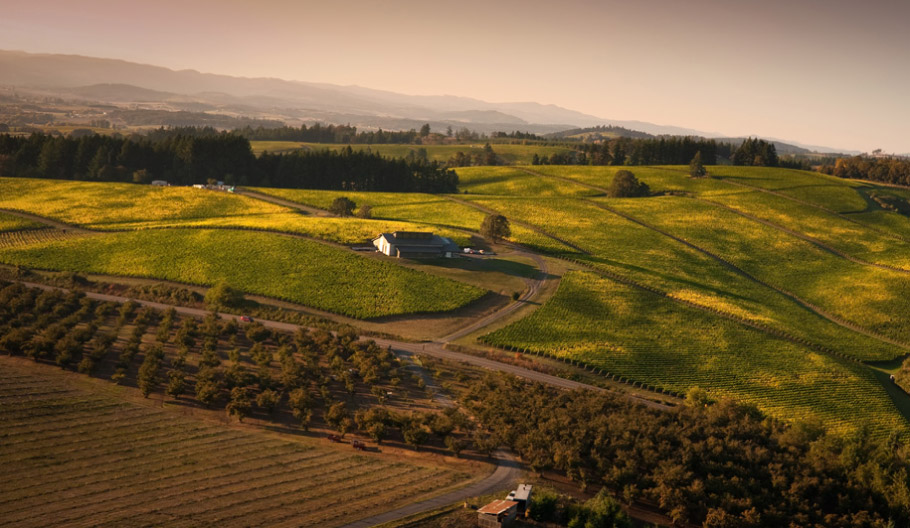Category: Press
The Ultimate Guide to Yamhill-Carlton AVA
Posted on June 11, 2021 in PressBy Erin James | Sip Magazine
The origin story of the Yamhill-Carlton AVA in Oregon’s Northern Willamette Valley is more intricate and involved than just its 2004 establishment. It’s more than the low ridges that surround the two towns of Yamhill and Carlton in the shape of a horseshoe, more than the North Yamhill River that courses through the rich agricultural land, the forestry encasing it, the Coast Range’s rain shadow coverage or even the ancient marine soils.
This story is about the right plant in the right place. The tale begins in 1995 when the burgeoning collection of Northern Willamette Valley winemakers, grape growers and community members came together to create six sub-appellations of their own.
“Any time you’re trying to create anything of this magnitude, there is endless strife to do it and the fact that we pulled it off is amazing,” says Ken Wright, proprietor and winemaker of acclaimed Ken Wright Cellars, who was instrumental in writing the FDA proposal for the six regions to receive individual designation. “We came together to identify the world-class parts of the Northern Willamette Valley as we were seeing different qualities coming from the different regions.”
In their experience of farming and producing wines in these neighboring areas, the community of vintners concluded that each region’s distinctly different soil material resulted in producing distinctly different wines. Volcanic soil material, such as that found in the Dundee Hills, would produce Pinot Noir that had a red fruit–focused profile, with strawberry, cherry and raspberry. In Eola-Amity Hills, which is also volcanic in its soil, they found darker fruits like cassis, blackberry, blueberry and black cherry. In the old ocean bed with marine sediment of Yamhill-Carlton, Wright says a divergent, savory profile emerged with anise, clove, tobacco, cedar and fresh-turned earth.
Wright explains that the source of these regional differences isn’t the soil, per se, but the soil series — the entire profile that encompasses the soil, the root system and the parent material, or “mother rock.” In Yamhill-Carlton, that ancient marine mother rock — created 200 million years ago with the evolving coastline — is the base material that contributes to what Wright calls a “treasure trove of trace elements,” such as magnesium, potassium, calcium, iron and copper that contribute to its identity of place.
“Those trace elements provide health to the plant, but in our world what’s equally important is whatever trace elements below the soil will end up being the influence that creates the profile of that wine and that place,” Wright details. “As farmers, we hope to be that deep into the mother rock. You have to be farming in that way to have the right populations of microbiology to deliver trace elements. We need those aerobic, microbial populations to be successful, we need them to create wines that truly connect us to place.”
Wright likens Northern Willamette Valley Pinot Noir to San Marzano tomatoes, the famed plum tomato variety originally from the small Italian town of San Marzano sul Samo, grown in volcanic soil in the shadow of Mount Vesuvius. “San Marzano tomatoes are amazing because that plant found its perfect home,” Wright says. “We have that here, this very small area of the Northern Willamette Valley that covers all of these AVAs, this part of the world was just waiting for Pinot Noir to be planted here.”
For Pinot Noir, and other varieties grown in the Yamhill-Carlton AVA, marine sediment makes up the soil series and builds the character of the wine. Wright says that coarse, granular, well-drained mother rock loses moisture as a result of its composition, therefore influencing the vine to ripen earlier than a region with volcanic material — a bonus for growers and winemakers as this can mean avoiding a lot of fruit-destroying weather issues, like rain. That, among a few other reasons, is why seven of the 13 single-vineyard Ken Wright wines hail from this region.
“I love all the regions but I love this profile,” the winemaker says of the AVA. “When we are perfectly ripe, we tend to have a little bit less acidity than the volcanic [sediment areas] so the wines here tend to be lush and enjoyable right out of the gate. We tend to have both blue and red fruit, a beautiful, seamless marriage of the two. Underneath that, there’s cocoa, tobacco, cedar, baking spices and a fresh earthiness; lots of floral qualities, but not herbaceous — it’s more like violet and rose. The wines tend to be quite complex and texturally very enjoyable.”
Dig into the ancient marine soil series of Yamhill-Carlton by way of these seven wines — each of which found their place in this unique Northern Willamette Valley AVA.
Ken Wright Cellars 2017 Savoya Vineyard Chardonnay
Ken Wright, a bona fide Master of Pinot Noir, colors outside that varietal box just a few times to showcase what also grows beautifully in Yamhill-Carlton: Chardonnay clone Dijon 548 planted on half an acre at Savoya Vineyard. Fermented and aged in French oak barrels, the wine is brilliant, clean and vibrant. A lovely glycerin quality peaks out with beeswax on the nose and a mouth-filling texture on the palate, while honeycomb, white flower, guava and mineral rest on bright acid. | $55 Click Here to Purchase
Ken Wright Cellars 2017 Savoya Vineyard Pinot Noir
Tasting Ken Wright’s wines back-to-back draws a parallel of sophistication between them, a consistency that exudes supple texture, savory qualities and a freshness that allows the wines to be enjoyed now, or later. Spice and floral notes bloom in front of the red fruit in this wine, but make way for smoked cedar, mineral, cola, blackberry and more of that red fruit. Complex, smooth and with brilliant clarity. | $62.50 Click Here to Purchase
Wine Enthusiast: 10 Vineyards Behind the World’s Most Famous Wines
Posted on March 10, 2021 in Press
Shea Vineyard
Because of Burgundy’s storied pedigree, Pinot Noir is almost as noble as grapes come. And Pinot Noir in the States is gaining a foothold. Even Burgundian denizens praise Oregon’s Willamette Valley for its great terroir for Pinot production.
The region’s Mecca is often considered to be Shea Vineyard, a 290-acre property in Yamhill County renowned for its sedimentary sandstone soil. Shea dedicates 149 acres to Pinot Noir and six acres to Chardonnay.
Proprietor Dick Shea supplies grand cru-quality grapes to some of the most vaunted and well- known Oregon and California wineries.
Notable Producers: Bergström, Ken Wright Cellars, Shea Wine Cellars, Winderlea
Vogue Magazine- The Best Wines to Drink With Takeout, According to Sommeliers
Posted on October 28, 2020 in Press
Sure, you know the basics: White wine goes well with fish, red wine with red meat—a perfect rule for the simple week-night dishes you whip up at home. Going out and want something more complicated? You can just ask your waiter, or the restaurant’s sommelier, for suggestions.
But what happens when two culinary worlds collide, and you order out to eat in? You’re probably in that situation a lot lately. (Here’s a statistic for you: in May, DoorDash—the online delivery service that also owns Caviar—reported orders were up 110 percent since the beginning of the year. During lockdown, people were stuck inside, and therefore ordering in more.) It often presents a pairing predicament: what, exactly, goes well with spicy pad thai, Shake Shack, or the sausage pizza you ordered hungover on a Sunday night?
In an act of extremely important service journalism, Vogue asked sommeliers and wine experts from across the country to help us solve this particular quandary. Without further ado, our definitive guide on the best wines to pair with your takeout, from fried chicken to Chinese food.
Pizza
Pinot Noir. “In today’s time of take-out and eating at home—a personal favorite (and minor guilty pleasure) is pizza and a good bottle of Pinot Noir. If we have classic Margherita or mushroom pizza, a great pairing can be red Burgundy, preferably Gevrey-Cambertin or Nuits-Saint-Georges, as their fruit expression will not overpower the taste of the simple ingredients. If we have pepperoni or pizza with any type of meat or spice, some great pairings would be with Nebbiolo or Sangiovese because of their raspberries, cherries, dried fruit and leather notes, as well as higher tannins that can hold their own when up against that type of food.”
-Marija Mijic, sommelier and beverage director at La Mercerie
Sparkling wine. “Sparkling wine is a great style to have in the fridge because it pairs excellently with many takeout options. It will enlighten a vegetarian dish, cleanse your palate when eating fried food, balance out a spicier dish, and, my personal favorite, will pair beautifully with white pizza.”
-Geneviève Pelletier, partner at Lieu Di
Lambrusco. “Lambrusco and pizza are one of my favorite pairings. It has a little fizz to cut through the melty cheese plus a savory side for the tomato, spices, and pepperoni. Vigneto Saetti Lambrusco is a slightly earthy bottling that is great with mushroom pizza and the nuttiness of parmesan.”
-Amy Racine, beverage director of JF Restaurants
Barolo. “I cooked in Piemonte for two years and naturally ate a lot of pizza and drank a lot of red wine. On pizza nights (or afternoons), Italians didn’t shy away from opening a nice bottle of red wine which always elevated the experience. The dusty fruit and juicy tannins of Nebiollo’s like A. & G. Fantino “Cascina Dardi” Barolo cut through the rich mozzarella and transports me back to Piemonte.”
-Kelly Mariani, culinary director at Scribe Winery and former chef at Chez Panisse
Sushi
Champagne. “Raw fish and bubbles work really well together. I had this fun pairing last week with Marie-Noelle Ledru Extra-Brut Grand Cru. It’s all about clean fresh flavors and rich textures. This combo feels luxurious and celebratory!”
-Kelly Mariani
Riesling. “When it comes to sushi, it depends largely on what type of sauces are used and the way it’s prepared. Riesling—especially semi-sweet to sweet style—is the perfect pairing if there is wasabi or ginger. Riesling’s apple, pear, quince and sometimes even expressive citrus notes, along with the residual sugar and bracingly high acidity, are magically harmonious with spice.”
-Marija Mijic
Assyrtiko. “A colorful and fresh array of sushi calls for an equally fresh and tart wine. Assyrtiko is a Greek grape variety that has a tone of mineral that pairs well to fresh fish and anything briny like the seaweed wrapper on your favorite roll. Sigalas makes a great Assyrtiko from Santorini, where ocean winds are constantly whipping around the grapes. You can taste that saline quality in the wine so it pairs perfectly to any sushi or sashimi.”
-Amy Racine
Mexican Food
Chenin Blanc or Chardonnay. “Sonoma has some excellent Mexican food and I’m often grabbing Mexico City-style street tacos with friends. Alongside tacos, I love drinking crisp and textural white wines, like Chardonnay or Chenin Blanc, especially our friend Joel’s Las Jaras Chenin.”
-Kelly Mariani
Pinot Noir. “A hearty burrito with a spicy salsa calls for a juicy, but low tannin red wine so it doesn’t amplify the spice (in a bad way). Willamette Valley makes excellent Pinot Noirs in Oregon that fit the bill perfectly. Ken Wright makes a style that has a smokey tone for the beans and char on the tortilla. It’s fruitiness comes by way of plum and blackberry flavors, which are especially great for a beefy carne asada burrito.”
-Amy Racine
Champagne. “Champagne can be sweet and toasty, but a Gronget Blanc de Blancs Brut is bright, citrusy, and savory. It’s my go-to for anything spicy and smokey. Mexican flavors just seem to be the perfect match.”
-Christine Collado, general manager at Parcelle Wines
Pet’Nat. “I eat Mexican food about three times a week because there is a good place across the street from work. I usually get a crispy fish taco, guacamole and chips and then build from there. The Texan in me always wants a Mexican beer to wash it all down, but for a wine substitute, Pet’Nat gets the job done. It’s a little more raw and extremely expressive. Those ingredients work well with a lift of acidic bite and bubbles make every bite brighter.”
-Zwann Grays, Wine Director at Olmsted
Fried Chicken
Rosé. “A dry rosé is great with fried chicken. You need something really dry and tart to be refreshing between those crunchy bites of chicken. Plus, if it’s a well-seasoned fried chicken or has a little spice/hot sauce, the fruit from rosé cools you off and gets you ready for the next piece. La Fête du Rosé is one of my favorites from Saint-Tropez—it’s dry, crisp, and refreshing.”
-Amy Racine
Chardonnay. “Chardonnay from Burgundy can take any chicken dish and make it fancy. Even if it’s from Chick-Fil-A.”
-Christine Collado
Chinese Food
Chablis. “Chablis and Crab Rangoon are a knockout. The region of Chablis in France only works with Chardonnay, but doesn’t use new oak, so it isn’t too heavy or buttery. It just has a creamy texture to it which echoes the filling of the Rangoon. The flavors of the wine are slightly nutty, like blanched almond, which pairs to that flakey wonton wrapper.”
-Amy Racine
Rosé. “When I’m not drinking Scribe rosé I’m drinking Domaine Tempier thanks to my years in the kitchen at Chez Panisse. Tempier’s Matriarch Lulu just passed, giving us yet another reason to raise a glass of this delicious wine. This iconic rosé is refreshing and rich enough to compliment the myriad of flavors and complexities of Chinese cuisine.”
-Kelly Mariani
Thai Food
Riesling or Pinot Noir. “Our favorite wines to drink with Thai food are either an off-dry Riesling or Pinot Noir. The sweetness of the riesling goes well with the mouth watering spiciness, and a lighter pinot noir complements the full flavors of the food.”
-Bobby Leonardo, bartender at Wayla
Rosso Sicilia. “Have this delicious Sicilian red with a chill. Pair it with noddles or a curry. It’s great.”
-Christine Collado
Burgers
Nouveau or Beaujolais. “Nouveau is our first glimpse into this year’s harvest and we’re bottling our 2020 vintage this week. Alongside a burger, I want to drink a chilled, crushable red wine from California or Beaujolais in France with enough body to stand up to the juicy meat and smokey char.”
-Kelly Mariani
Australian Grenache. “The only thing to order from In-n-Out is the Double-Double with cheese, and the only thing to drink with it is Australian Grenache. Because burgers are primarily defined by grease and heaviness, they call for wines that are big on flavor, body, and alcohol so they don’t get buried in the starch-and-fat groundswell. This down-under twist on the classically European grape is thick and dense, making for a heavy hitter combo of high tannin and alcohol that washes away any lingering grease from the meat and cheese. If you ask for your burger ‘animal-style,’ you’ll get it with mustard fried into each patty, plus pickles, chopped grilled onions and an extra helping of In-N-Out’s famous sauce (think Thousand Island Dressing). They all blend beautifully into the spiced plum, new leather, stewed berries and dried herbs that typify hot-climate Aussie Grenache.”
-Vanessa Price, author of Big Macs & Burgundy
Willamette Valley pinot noir loses a friend in Ruth Bader Ginsburg
Posted on October 1, 2020 in PressArticle by Michael Alberty | For The Oregonian/OregonLive
In 2008, Supreme Court Justice Ruth Bader Ginsburg and her family journeyed to Carlton, Oregon, to render a verdict on Willamette Valley pinot noir. It was a unanimous decision: delightful as charged.
In the wake of Ginsburg’s death last Friday, mourners celebrated her life and a legal career spent championing equal rights. Close friends also found time to remember Ginsburg’s more private pursuits. Opera singer and friend Joseph Calleja posted on Instagram: “Her love of food and wine only confirms that she was a perfect being.”
In September 2008, Ginsburg traveled to the Willamette University College of Law in Salem for the Oregon Civic Justice Center’s dedication ceremony. Despite a busy schedule of activities, Ginsburg found time for a secret mission: a visit to Ken Wright Cellars in Carlton.
News that Ginsburg wanted to meet with him was a bolt from the blue for winemaker Ken Wright.
“We only heard about it a week in advance. Then her security team called two days before she arrived to nail down every little detail, including the route we’d be taking to visit McCrone Vineyard,” Wright said.
The arrival of Ginsburg, her family, and Secret Service agents in black vehicles with tinted windows was not an everyday occurrence in the sleepy little wine town of Carlton.
“It was pretty funny with all those suits in sunglasses running around. It was also quite a scene when everyone packed into my winery office,” Wright said.
Ginsburg’s visit was exploratory in nature. According to Wright, “She was just getting into pinot noir, and she wanted to know why the Willamette Valley was so special. She wanted to know why this grape worked so well here.”
To tell the Willamette Valley’s story, Wright packed Ginsburg, her husband Martin “Marty” Ginsburg, and her daughter Jane C. Ginsburg off to McCrone Vineyard. The vineyard, owned by Don and Carole McCrone, is located just north of Carlton, in the Yamhill-Carlton American Viticultural Area.
“The vineyard sits on a ridgeline with a view that allows you to see everything from the Coastal Mountains to the Eola-Amity Hills. It’s a nice spot to explain things,” Wright said.
Wright’s family joined the group along with the McCrones and Mr. and Mrs. Michael Bennett from Willamette University. It was a warm day, so a tent was constructed, and as much water was poured as wine.
Wright remembers the Ginsburg family being knowledgeable about wine, with a wine vocabulary to describe what they liked and didn’t like.
“The words freshness, texture and purity came up a lot as they talked about Willamette Valley pinot noir. Especially purity,” Wright said. Oregon’s signature grape had a new set of fans.
The Ginsburg family left just as much of an impression on Wright.
“It was a super enjoyable two hours. Justice Ginsburg was an amazing, open person. We didn’t talk a lot about politics. We discussed wine and other mutual interests we enjoyed. She was definitely a thoughtful, critical thinker,” Wright said.
When the vineyard session concluded, the convoy traveled back to the winery, where Wright set up Justice Ginsburg with an assortment of wines based on their vineyard discussions. “Then ‘poof,’ she was gone,” Wright said. Wright returned to harvest preparation.
A few days later, Wright received another bolt from the blue: an envelope from Washington, D.C.
“It was just the most beautiful ‘thank-you’ note from Justice Ginsburg. Her family loved wine for all the right reasons,” Wright said.
— Michael Alberty writes about wine for The Oregonian/OregonLive. He can be reached at malberty0@gmail.com. To read more of his coverage, go to oregonlive.com/wine.
Note to readers: if you purchase something through one of our affiliate links we may earn a commission.
Photos of Ruth Bader Ginsburg’s Visit to Ken Wright Cellars & McCrone Vineyard
In Oregon’s Willamette Valley, Elegant Pinot Noir for Less than $40
Posted on September 10, 2020 in PressOctober 2020 Issue | Wine Enthusiast | Page 16
Click here to shop our Willamette Valley Pinot Noir

BY PAUL GREGUTT
Thin-skinned, petulant Pinot Noir is difficult to ripen and demands a gentle hand in the winery. Worse still, too many of its simple expressions fail to deliver on the promise of a grape whose impact has been described as the iron fist in a velvet glove.
When grown in the right place, under the right circumstances, however, the variety really delivers on its reputation for elegance, complexity and subtlety. The best examples are aromatic with notes of roses, berries and cherries, and offer balanced flavors of fruit, earth, herb and barrel, with ample natural acidity.
Oregon’s Willamette Valley American Viticultural Area (AVA) is widely acknowledged as the next best place after Burgundy, where Pinot has thrived for centuries, to explore its vast potential. First planted there by Eyrie Vineyards founder David Lett in the mid-1960s, the area is now the foundation for the state’s growing reputation.
After decades of experimentation, the valley today includes seven sub-AVAs. Each produces a distinct style of Pinot, based on differences in soil, elevation, aspect, farming and winemaker choices.
Good Burgundy is notoriously expensive, and in comparison, Willamette Valley Pinot Noir may be considered a bargain. That said, wines priced under $20, as well as those labeled plainly as Oregon Pinot Noir, rarely provide a thrill. Selections from specific appellations or subappellations priced under $40 would be a good starting point for exploration.
Six to Sip
Drouhin Oregon Roserock Pinot Noir Eola-Amity Hills; $35, 92 points. Anchored in a fast-rising AVA known to put an earthy subtext to ripe purple and black fruits, this has plenty of polish and power. Editor’s choice.
Ken Wright Pinot Noir Willamette Valley; $22, 91 points. This complex, layered wine is a fantastic bargain, aromatic and beautifully structured with raspberry and spicy plum fruit. Editor’s choice.
Lenné Estate LeNez Pinot Noir Yamhill-Carlton; $35, 90 points. Estate-grown fruit was gently aged in 10% new French oak, yielding near-term drinkability and medium ageability. Editor’s choice.
Pike Road Xander Taryn Vineyard Pinot Noir Chehalem Mountains; $35, 89 points. Fresh blackberry fruit meets wet rock minerality in this single-vineyard offering.
Stoller Pinot Noir Dundee Hills; $35, 89 points. From the heart of Pinot country, this wraps red and black berries with peppery herbs in a light, earthy finish.
Willamette Valley Vineyards Whole Cluster Pinot Noir Willamette Valley; $24, 91 points. Young, bright and delicious, this fruit-driven wine mixes fresh plum and cherry with just a hint of milk chocolate. Editor’s choice.










